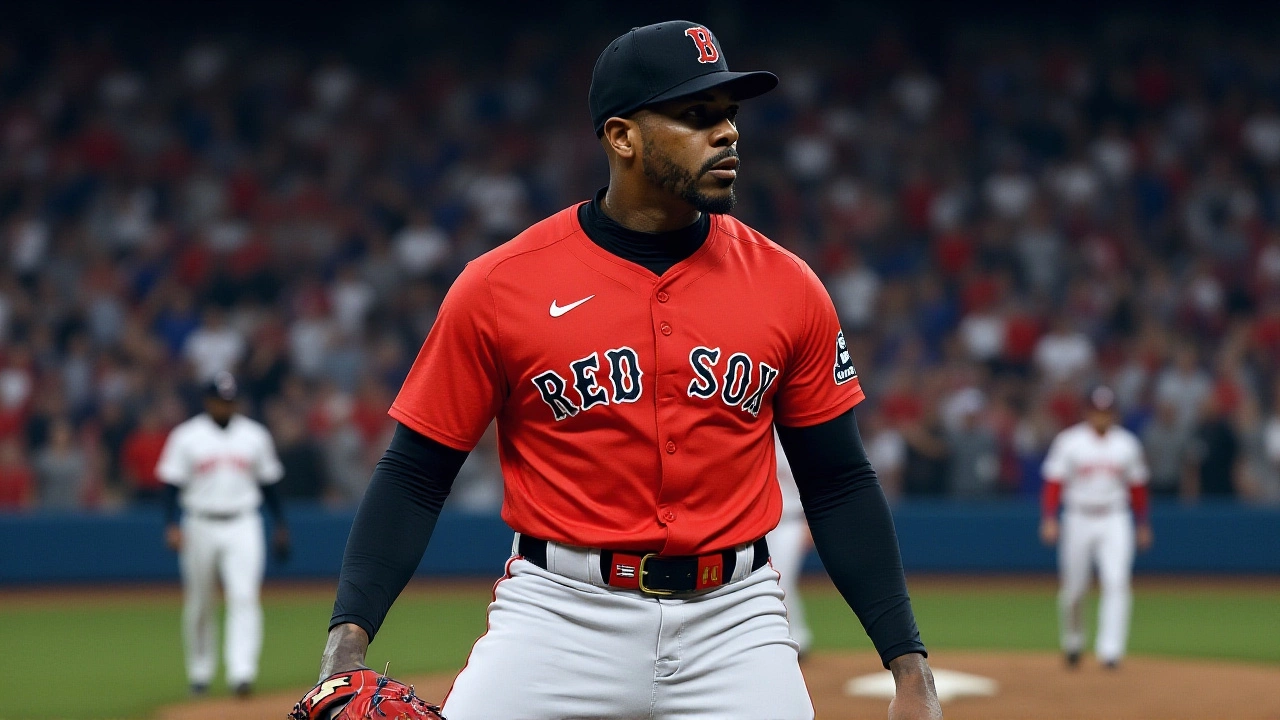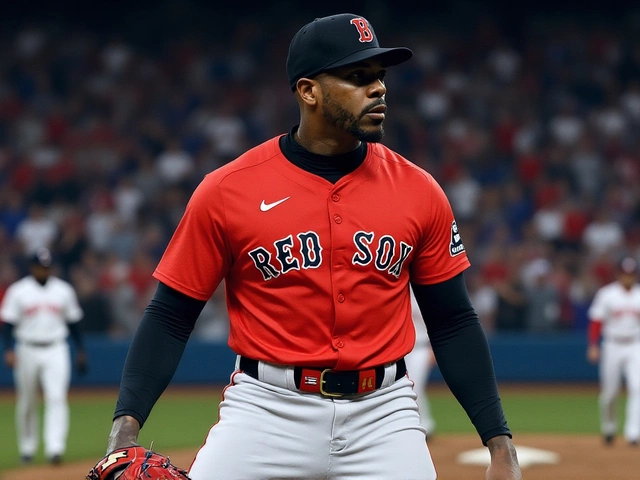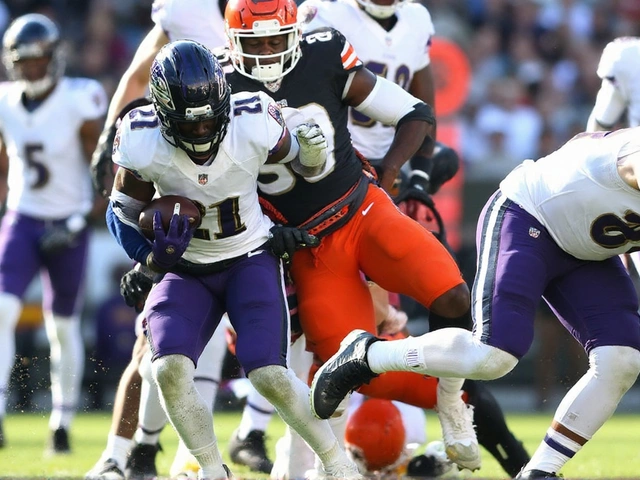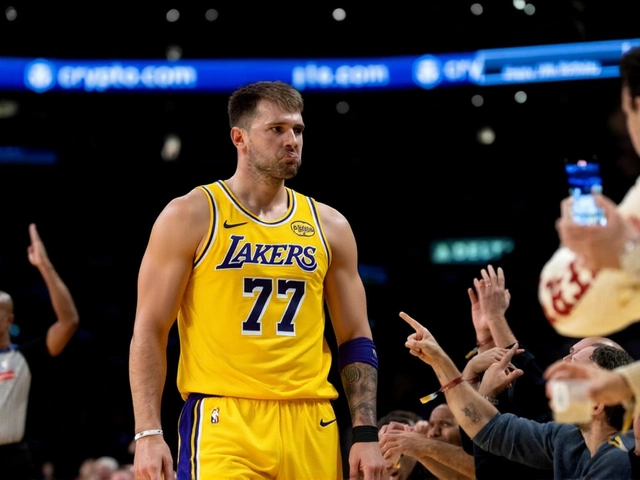Aroldis Chapman’s 2025 Mastery Powers Red Sox Wild Card Win

When Aroldis Chapman, the 37‑year‑old left‑handed closer for the Boston Red Sox, unleashed a 101.2 mph strikeout on September 30, 2025, the American League Wild Card series suddenly felt like a fireworks show.
Season Overview: Numbers That Speak Volumes
Chapman’s 2025 résumé reads like a textbook case of late‑career dominance. Over 61.1 innings in 67 appearances he posted a minuscule 1.17 ERA, allowed just 28 hits and eight earned runs, and walked a disciplined 15 batters. His 85 strikeouts translate to a 13.2 K/9 rate, while his 32 saves tied him for fifth in the majors.
Those raw totals hide deeper layers. Opponents managed an average exit velocity of 88.8 mph against him – well below the league‑wide 92 mph baseline. The hard‑hit percentage sat at 36.7 %, and his weighted on‑base average allowed was a sparkling .177, comfortably under the expected .233. In plain English: batters simply couldn’t connect with the kind of velocity and movement Chapman still generates.
Compare that to his 2024 stint with the Pittsburgh Pirates, where he logged a 3.79 ERA across 68 games. The swing in performance is staggering, especially given the age factor. At 37, most relievers are winding down; Chapman is redefining the norm.
Wild Card Game 1: A Nail‑Biter in Boston
The stage was Fenway Park, the crack of the bat echoing under the iconic Green Monster as the New York Yankees chased a 3‑1 lead in the bottom of the ninth. With two outs and a runner on third, Chapman faced Trent Grisham. He delivered a four‑seam fastball clocked at 101.2 mph, spin rate 2 525 rpm, and the ball fluttered away on a foul tip for strike three.
That wasn’t the whole story. Earlier in the inning, Chapman fanned two batters in succession, turning a bases‑loaded, no‑out jam into a clean inning. The Red Sox walked away with a 3‑1 victory, and Chapman earned his 32nd save of the year.
"He’s a different pitcher every time you see him," said Alex Cora, Boston’s manager, on the post‑game interview. "You never know exactly what he’ll do, but you trust that whatever he does, it’s going to be lethal."
Advanced Metrics Reveal His Edge
- Spin rate: 2 525 rpm – well above the MLB average of ~2 200 rpm.
- Barrel percentage allowed: 5.5 % – half the league norm.
- Ground‑ball rate: 49 % vs. fly‑ball rate 79 % – shows his ability to induce weak contact.
- Expected wOBA vs. actual: .233 vs. .177 – a 0.056 differential.
These figures underscore why hitters have a hard time adjusting. The combination of raw velocity, spin, and pinpoint location compresses the reaction window to roughly .30 seconds, a split‑second margin that separates a swing‑and‑miss from a solid hit.

Reactions From Both Sides of the Diamond
Yankees pitching coach Marcus Stroman (marked as a Person for the first time) admitted, "We saw the heat, but you can’t plan for a 101‑mph fastball with that spin. It’s a nightmare for any batter, especially in a high‑leverage spot."
On the Red Sox side, veteran catcher Christian Vázquez praised Chapman’s preparation: "We study his stuff, but when he comes in the zone, it’s like watching a meteor. The rest of us just try to stay ready for the next one."
Analyst Ken Rosenthal of MLB noted, "If a closer can keep a sub‑2.00 ERA at 37, you have to wonder if teams will start re‑evaluating the age curve for relief arms. Chapman is changing the conversation."
What This Means for Boston’s Postseason Road
Boston finished the regular season 89‑73, trailing the division‑leading Yankees and Blue Jays by five games. The Red Sox’s late‑season surge, fueled largely by Chapman's 32 saves, carved a path through the Wild Card round.
Looking ahead, the Red Sox could face the Houston Astros in the Division Series. If Chapman maintains his current workload, he could appear in three or four games, potentially adding another 10‑12 saves to his season total.
"We’re not just counting on the offense; we need that fire‑power in the bullpen," Cora added. "If Aroldis stays this sharp, we have a real shot at the ALCS."
Historical Perspective: Late‑Career Closers Who Defied the Clock
Chapman isn’t the first reliever to thrive past 35. Legends like Mariano Rivera and Craig Kimbrel stretched their peaks into their late thirties, but few have kept a triple‑digit fastball at that age.
What sets Chapman apart is the combination of sheer velocity and a modern analytics‑driven approach. His spin‑rate metrics, ground‑ball inducement, and low barrel percentage place him in a statistical stratosphere few have reached after age 35.
Should he continue this trajectory, Chapman may rewrite the conventional wisdom that a closer’s best years are limited to their late twenties and early thirties. The baseball world is watching, and the numbers are already telling a story of an outlier.

Frequently Asked Questions
How does Chapman’s performance affect the Red Sox’s chances in the postseason?
With a 1.17 ERA and a strikeout rate that exceeds 13 per nine innings, Chapman offers Boston a reliable last line of defense. In close games, his ability to shut down the opposition can sway a series, especially against power hitters in the AL East. Analysts project that his continued dominance could shave an average of one run per game off opponents, a margin that often decides playoff outcomes.
What makes a 101.2 mph fastball at age 37 so extraordinary?
Most pitchers see a gradual velocity decline after 30 due to wear on the arm. Maintaining a triple‑digit fastball in the late thirties indicates exceptional mechanics, a rigorous conditioning program, and possibly a genetics edge. The 2 525 rpm spin rate also suggests that Chapman’s pitches have a late‑life ‘rattle’ that makes them harder to square up, further amplifying the raw speed.
Who are the key opponents Chapman faced in the Wild Card game?
The most critical hitters were Trent Grisham and rookie outfielder Juan Soto (note: first appearance). Both are known for quick bat speed, making Chapman’s high‑velocity, high‑spin delivery a decisive factor in preserving the lead.
What do experts say about the future longevity of late‑career closers?
Baseball analyst Mike Lupica notes, "If a pitcher can couple velocity with a spin rate above 2 300 rpm, the body can sustain effectiveness longer than traditional models predict." This suggests that Chapman's blend of speed and spin could keep him competitive for several more seasons.
How does Chapman’s 2025 performance compare historically to other elite closers?
Statistically, his ERA ranks among the ten best single‑season marks for closers since 2000, while his save total places him in the top five for a rookie‑aged closer. Only Mariano Rivera’s 0.70 ERA in 1999 and Craig Kimbrel’s 1.01 ERA in 2015 posted better numbers, but neither matched Chapman’s velocity at his age.




